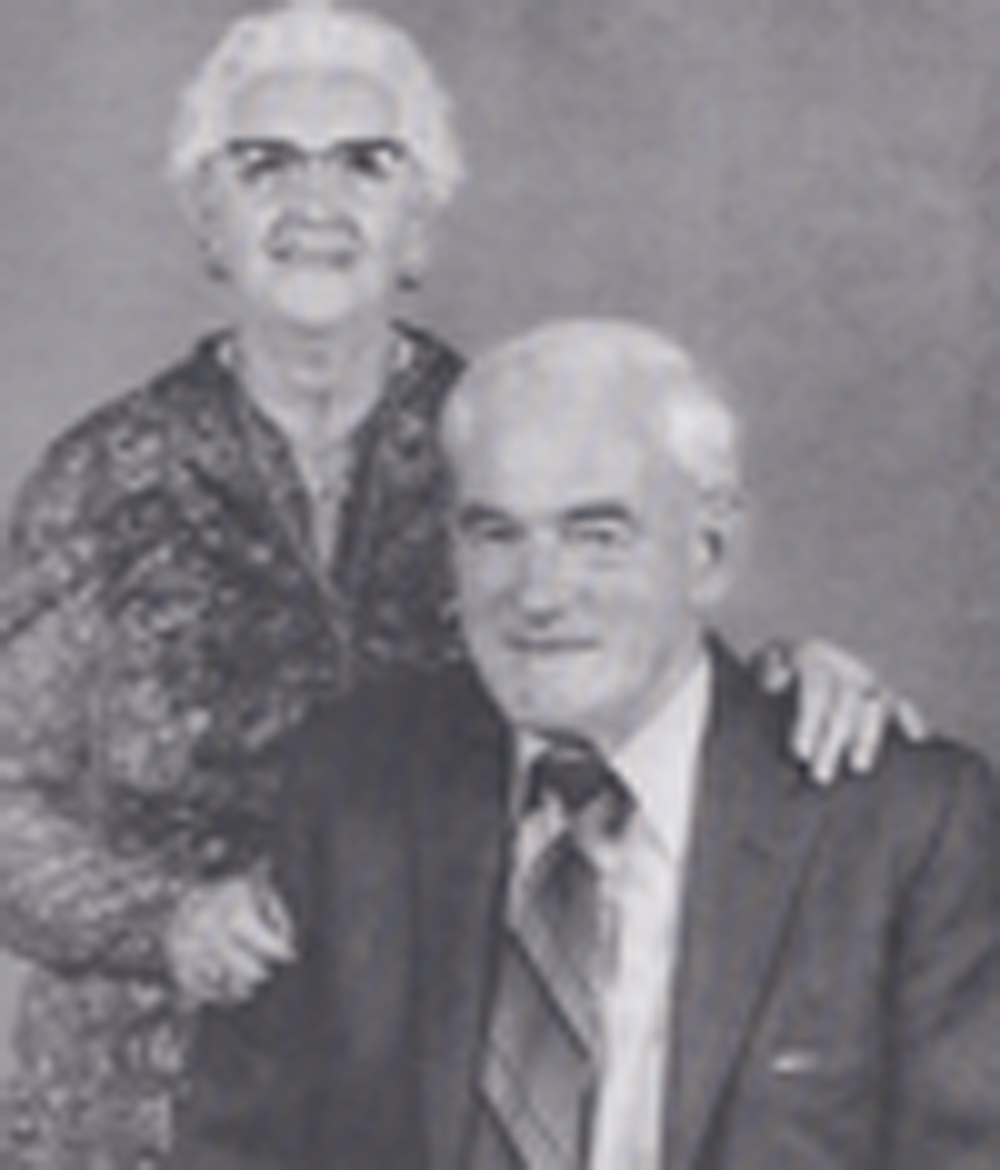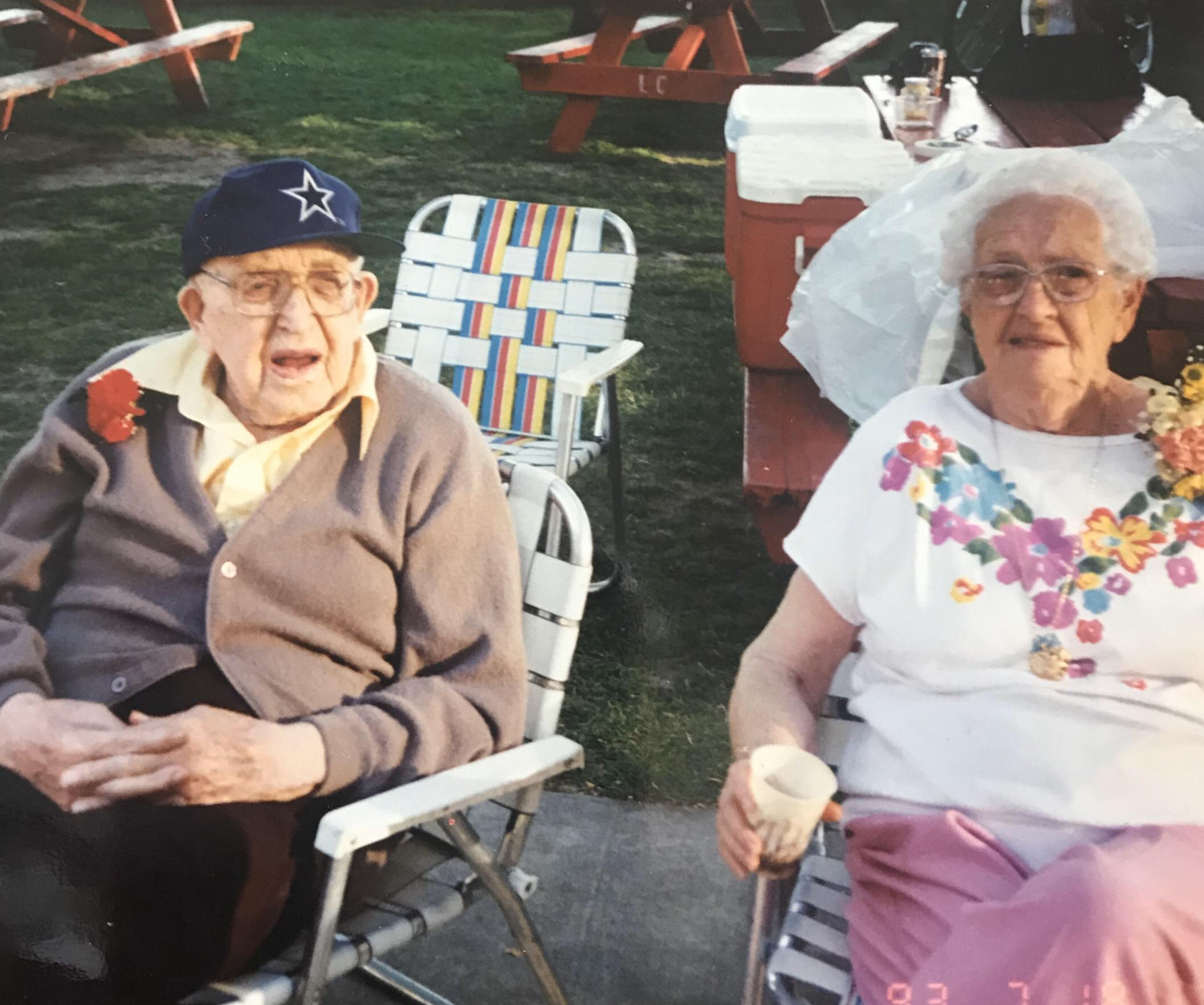This is the biography of Carrie Jensen Falslev Lewis.

This is the biography of Carrie Jensen Falslev Lewis.

The older Falslev cousins may remember at the Falslev Christmas Parties, Carrie as the one to gather everyone in a big circle and singing Christmas Songs to usher in Santa. In the center of the circle was a Christmas tree. Music and Christmas along with parties was a big part of her life. She lead the Benson ward Choir for many years, Just like her Father.
Carrie was born August 14, 1910 in Benson Utah. The family had purchased the farm of Peter Frost, a missionary that had been in Denmark. They had built a home on the bend just half mile south of the church. Carrie was born at home.
Carrie remembered her first home in Benson. The front door was on the north side of the house, entered into a big hall, which had hooks to hang coats. To the left was the front room and to the right was the kitchen, which had a small shanty added on. Carrie's parents' bedroom was to the north of the kitchen and upstairs there were two more bedrooms, one for the girls and the other for the boys.
The front room had an organ in it. Later, Marius gave this organ to the church because the church did not have an organ. They later bought a piano.
Many Scandinavian parties were held in this house. Many times they stayed all night due to the long ride home by horse and buggy.
The first church was located southeast of the present church. Carrie taught a boys class in the tower of the building. one day they got there before Carrie and locked her out by putting a table in front of the opposite side of the door so she could not get in. Carrie came up, and gave it a push and opened the door. The boys couldn't believe she had done it.
Living at home with no electricity made wash day a big event in the home. Carrie's family did acquire a washing machine that massaged the the clothes in hot water by means of an agitator that was hand operated. They would pull so many counts, then change off with someone else. The clothes were sent through a hand operated wringer before they reached the rinse water. The wringing process was repeated several times. the clothes then were hung on the clothesline to dry. Washing the clothes of nine took most of the day.
There was a lot of work to fire the stove, warm the water, pour it into the washer, and two tubs, then turn the washer crank, and the wringer handle and hang each piece on the line. This made it necessary to wear items more than once. Then they would iron the clothes by using a very heavy iron that was heated on the coal stove. They had two irons and would trade them off when they cooled down. This made it necessary to wear items more than once.
Baths were taken in the kitchen in a metal tub. Each person took turns in front of the warm stove.
All the shopping was done in Logan. They would go by horse and buggy and it would take most of the day. They would tie up the horse up behind the court house, bring some hay and feed it there. If they came home late the horse knew the way so they could sleep. The favorite horse was named Bess
Thanksgiving was a special holiday. They had a big dinner with turkey and all the trimmings. They even raised their own turkeys. One year they got attached to their turkey, Big Tom, and couldn't kill it for their dinner. So that year they had chicken instead.
Christmas was a special time in the Falslev home. The would have a Danish Christmas. Doing the things that their parents had done while living in Denmark. The tree was bought in Logan, then decorated on Christmas Eve. They made their own decorations from paper and would have a big dinner then dance around the tree. One year, Lydia caught fire to her apron from the candles on the tree. It was quite frightening. Carrie loved Christmas. One year, Carrie remembered that she and Edith found their Christmas dolls. They played with them for a long time. When Christmas morning came they had a terrible time pretending to be surprised. Needless to say, it was not one of her favorite Christmas and she never went looking for presents again.
The children learned the Danish language first, then English.
The Falslev family raised apples, pigs, and sugar beets. The girls had to herd the cows and the pigs. Their father was new to farming and had to learn by trial and error. Many times while the girls were herding the cows and pigs, the coyotes would come and scare them. The girls would jump up on the horse to get away from them.
Many indians stopped by their home because they had the only home on the street. Mother was very frightened of them and would hide the children, but she would always fed them. The indians lived in the river bottoms and would come up looking for food. Their huts remained for years in the river bottoms.
In the winter the family would cut ice from the slew in blocks and save it in sawdust. The ice would last through the most summer. They had a large dugout across the street, years later the children used it as a playhouse.
They loved swimming below the house. Mother would always be so frightened that she would stand up on the hill calling out to be careful.
They got their telephone in the 30's. Their phone number was 043-R1. It was a party line of about five families. Lower Benson was on the Logan telephone exchange and Upper Benson was on the Smithfield exchange. Therefore it was long distance to call Upper Benson from Lower Benson.
They always had dogs. One dog Carrie could really remember was a big black dog named Jack. He looked like a big black bear. They taught him to do many tricks and one was to climb up a ladder.
They also had a shetland pony named Sally who only liked dad. He used to irrigate his crops. Dad's feet, with his knee boots on, only cleared the ground by six inches when he rode her. Off they would go with shovel in hand to water the crops. When dad would stop to change the water, Sally would patiently wait for him to move on.
Carrie said whenever she got on Sally she would only trot up to Oga's place, turn around, and then come home. Carrie tried everything to get herto go, but to no avail. The granddaughter's also tried to ride Sally. She would run then stop quickly, throwing them overhead and onto the ground. Harold said when the boys got on her she would gallop, shaking them to pieces, until they got off.
Sally would wait by the house ready to go wherever Dad wanted to go. It was a sad day when she died.
Carrie's favorite color was lavender and her favorite flowers were forget-me-nots and carnations.
When Carrie was a child she had pneumonia and was sick for a long time. They did not think she was going to live, but she did. She had to learn to walk all over again.
Carrie was afraid of thunderstorms and would hide whenever one would roll around.
The roads to the Falslev's home was dirt and during the winter deep ruts would develop making them hard to travel on. Later the roads were graveled and then evetually had asphalt put on them. That was wonderful to them.
Carrie's family had family home evening in their home long before they were told to. The family always sang together.
The four girls also had to work in the fields, milk cows, and help with the cooking.
Carrie loved chicken dumpling soup, kale soup, and hamhocks. She loved making willow whistles and pin dolls. She learned to cook, can food, and make root beer.
The 4th of July they would go to Logan. They took a picnic lunch and ate on the court house lawn and watched the parade.
On Memorial day they would go to the Logan Cemetery and decorate graves.
Carrie's family built their first home, which later became Joyce and Bill Pitcher's house. They first built the barn and lived in it until they could finish the house. This house was the first time they had an indoor bathroom and furnace. It was a very special to them. They had several teachers live in the parlor for many years, while they were teaching school in Benson.

Marinus went to the service (World War I). He and his best friend Bert Riggs left together. Bert stayed in Virginia. Marinus went to France.
While Marinus was in training, Harold took sick and died. Marinus came home for the funeral. Carrie remembers sitting on his lap. She said he was so handsome in his uniform.
Carrie went to North Cache High School. She took violin lessons, was in sports, and participated in musicals. She took a sandwich each day because there was no hot lunches. She attended seminary for three years. Her teachers were W.W. Merrill and Elijah Hicken
Carrie met Russell (who lived with his sister Barbara). He came to help milk her father's cows. That was their first date.
Russell served in the U. S. Navy. He acquired the nickname "sailor", which he carried all his life.
They eloped to get married on July 26, 1929. Russell's sister, Martha and her husband, went with them. Carrie borrowed her wedding dress from Martha to get married in. The marriage was later solemnized in the Logan Temple. They first lived in her parents basement, where Anna Mae was born on May 29, 1930.
Morris Benjamin was born June 11, 1933 in Benson. Karen Fae was born May 12, 1938 in Benson. Danny Brent was born October 12, 1945 in Logan. The twins, Willaim and Preston, was born on April 2, 1950. They died the same day.
Carrie worked in the fields, a tomato factory, picked beans, and a turkey factory. She worked for Mode-O-Day for 23 years. Russell work for the Cache Valley Dairy in Amalga for 28 years turning the big wheels of swiss cheese by hand.
Carrie enjoyed working in the church. At one time she held five positions in the church. She helped with many road shows.
She loved driving, She would take her mother anywhere she needed to go. She enjoyed taking her nieces and nephews to the show on Saturday nights.
For awhile both Carrie and Russell worked at the Deseret Industries. Carrie sorting, sizing and mending clothing and Russell worked in the shoe department. He would sort, disinfect, and polish countless pairs of shoes.
The Falslev Family did not grow up with electricity. Something Carrie said she would not like to go back to. In her retirement she loved to watch the Jazz play basketball, visit family and just sit outside enjoying nature.
Russell passed away on February 28, 1985 at age 80.
Carrie passed away on June 24, 2001, at age 90.
